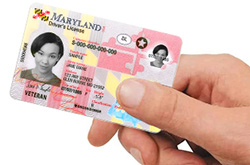MVA adds hours, appointments and staff to handle REAL ID volume
By Len Lazarick
The Maryland Motor Vehicle Administration has added hours, staff and appointments at its offices to cope with the increased volume of drivers who must present four or more different documents to obtain a Real ID drivers license that complies with federal law.
Drivers must get the compliant licenses by October 2020 in order to board a commercial aircraft or enter a federal facility. The new requirements have ballooned the number of drivers licenses renewals from 10,000 a month to 100,000 per month, according to MVA officials.
In an interview, MVA Administrator Christine Nizer said the agency has also clarified rules for its staff for judging the eligibility of passports, marriage certificates and other documents that have created problems for some people. She said the agency’s REAL ID website has also been updated with more information about the documents required.
The MVA said it has added 2,700 appointments through May 4, with 1,900 added permanently. Customers with appointments are guaranteed to be seen within 15 minutes of their scheduled time.
MVA customers without appointments on Saturday were having wait times of 45 minutes in Beltsville to as long as 110 minutes in Glen Burnie, based on the agency website.
The busiest high-volume branches — Annapolis, Bel Air, Columbia, Glen Burnie, Largo, Parkville, Waldorf, and Walnut Hill — are now open till 6:30 p.m. on Tuesdays in addition to Saturday hours. All MVA branches are open on Thursdays till 6:30 p.m.
Appointments help spread out the volume of customers
Nizer said, “If we can get people to make more appointments, we can spread that [extra volume] out.”
Nizer insisted that the higher volumes have not reduced MVA’s commitment to “providing premier customer service” and it has added 100 staff members to handle the high volume.
She said that 79% of customers respond to post-visit surveys and 98% of respondents said the MVA was “friendly, helpful and professional.”
“I think what it shows we’ve done a lot of training,” Nizer said.
REAL ID has been in the works since 2005 when Congress passed the original law as a post-9/11 counterterrorism measure. There was strong resistance to national ID cards, so Congress made the states do the job for them.
Some states, such as Pennsylvania, resisted the move and is now only issuing compliant licenses, while Maryland has been cooperating with the U.S. Department of Homeland Security for years.

MarylandReporter.com is a daily news website produced by journalists committed to making state government as open, transparent, accountable and responsive as possible – in deed, not just in promise. We believe the people who pay for this government are entitled to have their money spent in an efficient and effective way, and that they are entitled to keep as much of their hard-earned dollars as they possibly can.

